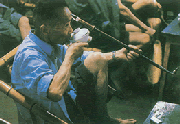
Chinese tea culture is among the best of Chinese culture. The tea ceremony is a very profound and complex thing, and it seems that only with a pure heart and few worldly desires can a man get its quintessence.
However, for the common people, at least those in Beijing, such a state free from vulgarity can never be attained. Therefore, the teahouses in Beijing, different from those in other places, have never been places of peace and quiet. Instead, they are always hustling and bustling. Perhaps this has something with the Beijingers' disposition: fearful of quiet, and fond of communication, especially that of group chatting. Hence, the teahouses provide perfect venues for them to gather together and talk of everything under the sun with great gusto.
 Teahouses in Old Beijing
Teahouses in Old Beijing
The Beijing teahouse came into vogue in late years of the Qing Dynasty(1644-1911), with a great variety, such as green-tea, book-telling, wild, and wine teahouses.
Green-tea Teahouse

The green-tea teahouses, which were among the best in old Beijing, served as resting places for the aged people and rich spoiled children after walking their birds in the morning, and for merchants to discuss business matters over a meal at noon.
Teahouses of this type were usually simply yet elegantly furnished, with square tables and wooden chairs, focusing their business on selling tea, which was usually served in a covered tea bowl. In spring, summer, and autumn, shelter would be set up outdoors or in the courtyard. As a rule, those regular customers sat inside the teahouse, while the infrequent guests sat under the shelter. Private seats were available in the courtyard. Only top quality Chinese green tea, such as the brands of Mao Jian, Yuqian (Before the Rain), and Queshe (the tongue of a sparrow), was served in this type of teahouses.
In the morning, most of the frequenters to these teahouses were aged people, who got up very early for morning exercise. After that, they would pay a visit to the teahouse, and have a small talk with other teahouse-goers. From time to time, the teahouse owners would come up with some creative ideas to attract customers. For example, some of them would organize the so-called "Meeting of Birds," and send invitations to those bird-raisers, who would often be willing to come and talk about their bird-raising experience.
By the noon, when the aged people had gone home for a rest, another group of customers, mostly business people, visited the teahouse, and talked about their business over a cup of tea.










